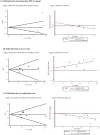Short-Term Outcomes of Trabeculectomy With or Without Anti-VEGF in Patients With Neovascular Glaucoma: A Systematic Review and Meta-Analysis
- PMID: 37728893
- PMCID: PMC10516766
- DOI: 10.1167/tvst.12.9.12
Short-Term Outcomes of Trabeculectomy With or Without Anti-VEGF in Patients With Neovascular Glaucoma: A Systematic Review and Meta-Analysis
Abstract
Objectives: The aim of this study was to compare the safety and efficacy of trabeculectomy alone or combined with intravitreal injections of anti-vascular endothelial growth factor (anti-VEGF) agents for the treatment of neovascular glaucoma.
Methods: We conducted a systematic review and meta-analysis to compare the effects of trabeculectomy alone or combined with intravitreal injections of anti-VEGF agents for the treatment of neovascular glaucoma. We searched four databases (PubMed, Cochrane Library, Embase, and Web of Science) up to January 2023 and extracted data on three surgical outcomes: postoperative intraocular pressure, success rate and complications. We used a random-effects model to calculate pooled relative risk (RR) or standardized mean difference (SMD) estimates and 95% confidence intervals (CIs). We assessed publication bias using Begg and Egger tests.
Results: We included seven studies with 353 eyes. Compared to trabeculectomy alone, trabeculectomy with anti-VEGF had a lower risk of postoperative complications (RR, 0.60; 95% CI, 0.41-0.89) and higher success rate (RR, 1.19; 95% CI, 1.02-1.40). The intraocular pressure reduction was significantly greater in the trabeculectomy with anti-VEGF augmentation group than the trabeculectomy group from 1 week (SMD, -1.36; 95% CI, -2.76 to 0.04) to 6 months (SMD, -0.79; 95% CI, -1.50 to -0.07) after surgery.
Conclusions: According to current evidence, adding intravitreal injection of anti-VEGF agents to trabeculectomy may improve the short time outcomes of patients with neovascular glaucoma.
Conflict of interest statement
Disclosure:
Figures


















Similar articles
-
The efficacy and safety of anti-vascular endothelial growth factor combined with Ahmed glaucoma valve implantation in the treatment of neovascular glaucoma: a systematic review and meta-analysis.Front Med (Lausanne). 2024 Jul 31;11:1405261. doi: 10.3389/fmed.2024.1405261. eCollection 2024. Front Med (Lausanne). 2024. PMID: 39144652 Free PMC article.
-
What is the impact of intravitreal injection of conbercept on neovascular glaucoma patients: a prospective, interventional case series study.BMC Ophthalmol. 2019 Jun 11;19(1):128. doi: 10.1186/s12886-019-1138-6. BMC Ophthalmol. 2019. PMID: 31185956 Free PMC article.
-
Intravitreal ranibizumab injection combined trabeculectomy versus Ahmed valve surgery in the treatment of neovascular glaucoma: assessment of efficacy and complications.BMC Ophthalmol. 2016 May 26;16:65. doi: 10.1186/s12886-016-0248-7. BMC Ophthalmol. 2016. PMID: 27230388 Free PMC article.
-
Management of neovascular glaucoma with panretinal photocoagulation, intravitreal bevacizumab, and subsequent trabeculectomy with mitomycin C.J Glaucoma. 2010 Dec;19(9):622-6. doi: 10.1097/IJG.0b013e3181ccb794. J Glaucoma. 2010. PMID: 20179624
-
A systematic review and meta-analysis of randomised controlled trials in the management of neovascular glaucoma: absence of consensus and variability in practice.Graefes Arch Clin Exp Ophthalmol. 2023 Feb;261(2):477-501. doi: 10.1007/s00417-022-05785-5. Epub 2022 Aug 8. Graefes Arch Clin Exp Ophthalmol. 2023. PMID: 35939118 Free PMC article.
Cited by
-
Surgical Treatment of Neovascular Glaucoma Secondary to Proliferative Diabetic Retinopathy in Japanese Patients without the Use of Glaucoma Drainage Devices.J Clin Med. 2024 May 31;13(11):3252. doi: 10.3390/jcm13113252. J Clin Med. 2024. PMID: 38892963 Free PMC article.
-
Surgical Outcomes of Mitomycin-C Augmented Trabeculectomy in Neovascular Glaucoma and Prognostic Factors for Surgical Failure in Thailand.Clin Ophthalmol. 2024 Nov 1;18:3111-3123. doi: 10.2147/OPTH.S485331. eCollection 2024. Clin Ophthalmol. 2024. PMID: 39502628 Free PMC article.
-
The efficacy and safety of anti-vascular endothelial growth factor combined with Ahmed glaucoma valve implantation in the treatment of neovascular glaucoma: a systematic review and meta-analysis.Front Med (Lausanne). 2024 Jul 31;11:1405261. doi: 10.3389/fmed.2024.1405261. eCollection 2024. Front Med (Lausanne). 2024. PMID: 39144652 Free PMC article.
References
-
- Shazly TA, Latina MA.. Neovascular glaucoma: etiology, diagnosis and prognosis. Semin Ophthalmol. 2009; 24: 113–121. - PubMed
Publication types
MeSH terms
LinkOut - more resources
Full Text Sources

